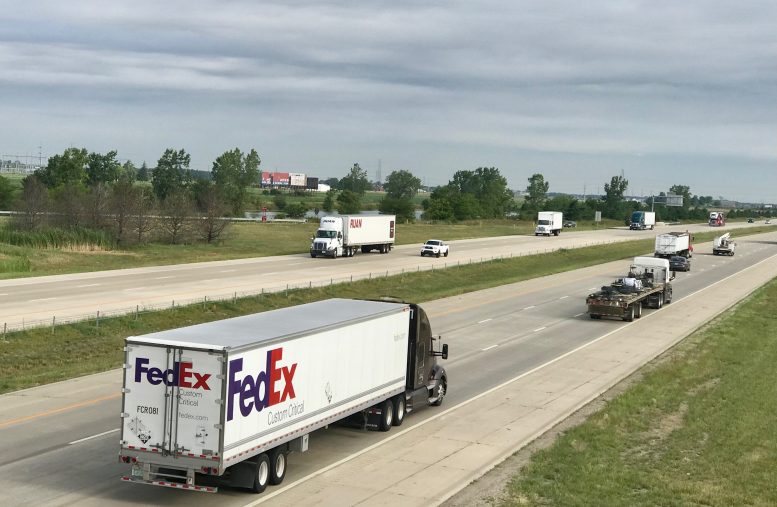By DAVID DUPONT
BG Independent News
Santa’s sleigh may be a little lighter this Christmas.
What’s under the Christmas tree, what’s on the Christmas tree, and what’s to munch on the holiday buffet will depend on the machinations of a global supply system still reeling from the coronavirus pandemic.
The supply chain – the system by which products make it from the factory a farm into our homes – became big news in the early months of the pandemic. Toilet paper, flour, and other necessities suddenly were hard to find.
Eighteen months later, uncertainty still exists, though the reasons may have changed.
“This is an ongoing crisis created by COVID because of uncertainty in transportation, labor regulations and uncertainty labor supply,” said Professor William Sawaya, chair of the Management Department at Bowling Green State University. “It is a labor crisis that created this problem.”
It comes down to “how many people you have to manufacture products, how many people you have to move them around – to drive the trains, the trucks to load that load, how many people you have in the offices coordinating everything,” he said. Even how many people in government enforcing regulations.
“I’ve heard anecdotally that manufacturing facilities are having trouble getting at most up to 80 percent staffing,” he said. “Nationally, it’s a really big issue.”
But it is not the only issue.
“What’s crazy about supply chains is they’ve gotten so long and so global and we source at least some parts of the product from all over the place,” he said And COVID doesn’t strike all places at the same time. Instead it “cascades through countries at different stages.”
So while it may wane in Spain, it surges in Korea. Maybe it gets better in the United States but Japan and Sweden have locked everything down.
How countries deal with the pandemic differs as well, Sawaya said. “China has tended to lock things down. … You may have something ready to ship, and it’s loaded ready to be loaded and a dock worker shows up with COVID and they shut the port down. It’s a good containment strategy, not a great supply chain strategy.”
Compounding the problem is the trend in industry over last 30 years to operate as lean as possible. Waste is eliminated. Processes are streamlined and made efficient as possible. In times of certainty, Sawaya said, that saves a lot of money. “On the other hand when there is uncertainty and the process doesn’t have a lot of capacity and lot of inventory, and you need to ramp up then you’re in trouble,” he said. “We maybe don’t have as much capacity as we should have because we were running as close to the edge of what we needed because that’s most cost efficient.”

Despite that web of problems, Sawaya said, the shortages won’t be widespread. “We may run out of specific food or specific things you’d like to give as a gift or specific things you’d have like to decorate your home or your business.”
At this point if it’s not on the way, the likelihood of a product arriving by the holidays is slim.
“All the transportation lead times are really, really long,” he said. Products coming from Asia are taking twice as long as normal, and what used to take a week to get from the West Coast is now taking six weeks.
“For businesses … if they ordered early enough there’s a decent chance they’ll have it,” he said. “If they didn’t think to order really early, they may not have it until Christmas and some things won’t show up at all.”
The same dynamics, he said, come into play with getting the raw materials and the components needed to manufacture products.
“There will be out and out shortages of some items,” Sawaya said. Some because they will just not be available, and other items because they are caught up in shipping and won’t arrive in time. But as of now, outside of a few insiders, no one knows where those shortages will be. “It’s just speculation.”
Also, uncertain is how long these supply chain bottle necks will last.
Sawaya expects some easing after the Christmas rush, as the U.S Postal Service, UPS and FedEx get a chance to catch up.
“My opinion is we’re not going to see things improve dramatically for the next six months,” Sawaya said. “It’s not a quick fix.” Sawaya said the problems could persist for as long as three years. “I hope I’m wrong.”
Shipping delays will ease more quickly. But other problems persist.
When COVID struck, the automotive industry halted production and canceled orders for the computer chips it needed. The chip manufacturers then switched gears and started to make the chips needed for lap tops, modems, and web cams, devices in demand by people working from home.
That demand persists even as demand for chips for the automotive sector picks up.
The manufacturers could build new factories, but those cost $1 billion, and getting specialized machinery needed faces the same supply issues as other sectors.
Sawaya also noted that the chips used by automotive manufacturers are old, but proven technology. They need to be because they are used in safety features. But manufacturers aren’t going to build a $1 billion factory to build old technology.
“The auto companies may have redesign themselves out of this one,” he said.
The labor “shortage,” Sawaya said, is likely to linger.
“A lot of people have exited the workforce for a variety of reasons,” he said.
While American workers have stayed on the job into their 70s, COVID may have changed that, he said. The changed structure of work and additional restrictions including having to wear a mask, “may have caused a lot people in their 60s and 70s to just hang it up and exit the workforce.”
Also, he said, two-earner couples may have realized that they could get by on one income, or one and a half incomes, so one of the partners spends more time at home.
[READ RELATED STORY: Burden of pandemic parenting fell disproportionally onto mothers, researcher reports]
Another controversial argument is that the supplemental unemployment payments encouraged many workers to stay home, some because of concerns about health, others because the few extra dollars they’d earn weren’t worth returning to work. Sawaya said he feels this has made a significant difference.
A smaller impact on the workforce were the loss of people who died from COVID, or those who got so sick they are disabled.
The most important action the government can make, Sawaya said, is the continuing push to get people vaccinated. “The solution is vaccination. Government policies there can make a difference.”





